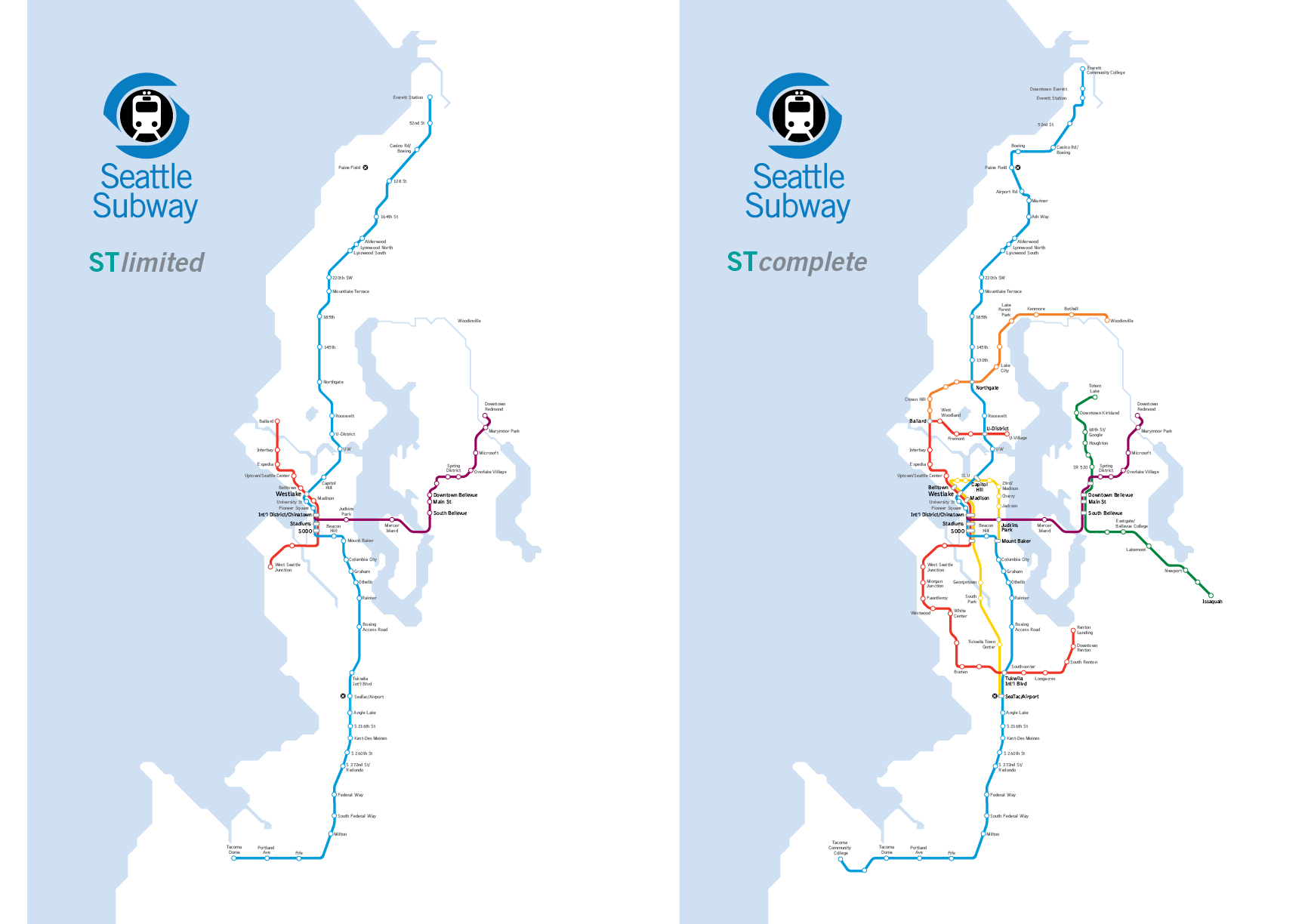On Wednesday, I sat down with Jonathan Hopkins, the Political Director for Seattle Subway. Last July Seattle Subway released a bold proposal for Sound Transit’s next ballot measure to expand the regional light rail system. Dubbed “STcomplete,” their plan would double the proposed 15-year Sound Transit 3 (ST3) measure to 30-years, funding a host of additional projects across the region. Below is a series of questions about the proposal, lightly edited for clarity.
Interview
Ben Crowther (The Urbanist): To start: why STcomplete?
Jonathan Hopkins (Seattle Subway): We’re behind and we’re one of the fastest growing regions in the country. We need to remain competitive for jobs and workers. People have to be able to afford to live here. Good transit helps affordability, improves access, and attracts talent.
If there’s an opportunity to do more projects — faster — without increasing our annual tax burden, why wouldn’t we do it? This complete plan would be faster because every time we stop for a vote, it means we’ve stopped planning and that delays each project three to five years. When we fail to vote on a comprehensive system, it means we don’t plan stations in a systematic way. It’s emblematic at Tukwila and U-District Station and SODO Station where lines will converge in the future. This will cause us to re-do stations a couple decades after they were built, wasting time and millions of dollars.
Our agency is doing a good job, but there are better ways. Washington, D.C. created a subway plan in 1968 and completed it in 2001 — a 30-year endeavor. In that time, only one station from the original plan was moved throughout the 100-mile system. Seattle’s regional population in 2040 will actually exceed that of the DC metro area when their system was completed.
We have an opportunity for leaders to demonstrate vision, to leave a legacy that a century’s worth of leaders prior weren’t able to achieve.
When ST3 was conceived in height of the Great Recession, people were talking about maybe doing Ballard to West Seattle. It was bullish then — it seemed impossible and far off. It’s now the minimum standard of what needs to be accomplished.
Are we serving all of our communities if we only serve West Seattle Junction or the core of Ballard? If we spend 5 to 10 more years, we can get to Delridge, closer to Lake City, and complete a great network a great city deserves.
But it’s not just about Seattle. There’s no subarea that doesn’t benefit from going longer. Snohomish County won’t have enough money to get to Downtown Everett in ST3. To afford it, money would come from Pierce and East King subarea. With STcomplete, we can complete the system and even include Paine Field.

Meanwhile, East King can build a full system, not just two stations to Redmond. Will two stations get votes? Will Bus Rapid Transit? Or will a network? People voted yes in ST2 because they got a full line. This measure won’t pass without East King County, so we need to deliver a real network for them to support.
In ST3, South King County would mainly get what it voted for in ST2, unless we go longer to connect places like Burien and White Center to the system as well as completing Federal Way.
Unless we do STcomplete, Tacoma and Pierce County will be asked to spend their money in other areas. But they need that investment in Pierce County to extend Link to more neighborhoods, add streetcars or get all-day Sounder service. The area does not suffer from over-investment; they should not be shipping their money elsewhere.
In so many of these cases, we can help people living in affordable housing get to jobs that serve their families well. But we can’t do that properly without rail. Every economic class in our region deserves these opportunities. Yes, this should include people living in West Seattle Junction and the Ballard core — but it should not just be limited to those that can afford to live there.
BC: How is this plan feasible from a legal standpoint?
JH: The State Legislature told us as a region what authority we had to charge certain tax rates. There was no limit placed on duration. When we talked about the package in 15-year terms, it was to assess the value of the package against other options. It was not a time limit, but was used to compare revenue package proposals.
Sound Transit’s legal requirements are to stipulate what will be built (after careful study) and produce a viable financial plan to support it. Then its up to the voters.
BC: Why do you think voters will be supportive of a 30-year plan and tax?
JH: Seattle Subway volunteers spend the summer talking with real citizens at community groups and farmers markets across the region—Mothers and fathers; schoolteachers; Amazon workers and retirees. When people see our map, they want it right now. We can’t produce it now, but we can get it. This plan produces more lines, faster, for more people, connecting more of each of our cities. It’s the best we can do to get a true city and region-wide system that is essential to supporting the job growth we want and the population growth we are destined to experience. Furthermore, the only way to do this at reasonable annual cost.
BC: What if the public wants to speed up construction down the line?
JH: There are a number of ways to speed it up. Let’s say the public already voted to approve STcomplete. If any entity or jurisdiction wanted to contribute more local, state or federal funds, then that would speed construction. Since ST would be able to plan many projects in parallel from the beginning, there would be more shovel-ready projects to execute when funds were made available. In 2009 when we had the Stimulus, it invested in shovel-ready projects. But they had a hard time finding them. If ST2 had included a complete plan, we would have had 2 to 3 times as many projects eligible for federal funds. That would have relieved the tax burden from local taxpayers and sped up the time to completion. The same would be possible in the future. This plan increases options, speeds up construction, and makes further acceleration possible. This is a strategic win.
BC: Could it spur demand for transit?
JH: Anywhere there are extensive rail systems, people ride it and love it. There is certainly a rail bias over buses. People from every location and economic strata will ride rail systems, especially when it’s well maintained (which Sound Transit does), serves important job and residential centers, and it goes where you need to go. The best systems go everywhere — they don’t leave people stuck. People can feel safe getting on the train and going where they need to go.
That allows us to have better bus service. When we restructure appropriately, we can save service hours and redistribute to feed people to rail. We will have riders — both of choice and necessity — in large numbers.
BC: Why hasn’t Sound Transit thought of or proposed this?
JH: I imagine some people at Sound Transit have thought of this, because it’s a good idea! But they follow the direction of the Board of Directors. It comes down to the vision of our leaders, the willpower they have to achieve it, and the legacy that they want to leave behind. Will voters reject a leader that has found a way — for the first time in 100 years — to solve one of our biggest problems and give us a complete transit system?
The worst thing we could do is to not build anything. The second worst is to underestimate the support of the public for comprehensive solutions. We know from the votes this last November that the community is hungry for transit solutions. We saw victories for Move Seattle, Community Transit, and a streets measures in Tacoma. We know from our public engagement that people want a complete plan and they want it now. So we need to find the best way to achieve that. There is zero denying that this is a more complete and faster approach than the incremental approach previously considered. And it can be achieved with zero increased annual tax burden.
BC: Shefali Ranganathan, the new executive director of Transportation Choices Coalition, was quoted in an article earlier today from The Stranger saying she was skeptical of the plan. She said the opposition signs write themselves and that people would call it the “never-ending tax.” What would you say in response?
JH: On one point we are in complete agreement with her: we look forward to seeing Sound Transit’s numbers on Friday and seeing what truly is possible. We are confident those numbers will show serving more neighborhoods and every economic class in our city is well within reach. Ultimately, that’s a principle the citizens of this great city (and many others) will embrace.
But you know, if our math is right, the simple choice between even just 30 years instead of 20 years has tremendous financial capacity impact. On the West Seattle line, for example, Shefali’s preference for 20 years is effectively choosing to leave out affordable neighborhoods such as Delridge, White Center and Burien for perhaps decades. Instead, the line would stop at comparatively affluent West Seattle Junction. Throughout the region, similar choices would be made with lines never quite reaching the most affordable places.
Some may be satisfied with stopping short. But I look forward to hearing from the people who actually live in our transit-dependent communities. I expect they will have a different answer — probably one reflected by most residents of Seattle and the central Puget Sound. The time for partial solutions to a comprehensive problem is over.
If you want to help shape the direction of ST3, make your voice heard by contacting the Sound Transit Board of Directors at EmailTheBoard@soundtransit.org. On Friday (December 4th), the Board will have a workshop meeting to discuss important policies that will lay the groundwork for an ST3 package.

Ben Crowther
Ben is a Seattle area native, living with his husband downtown since 2013. He started in queer grassroots organizing in 2009 and quickly developed a love for all things political and wonky. When he’s not reading news articles, he can be found excitedly pointing out new buses or prime plots for redevelopment to his uninterested friends who really just want to get to dinner. Ben served as The Urbanist's Policy and Legislative Affairs Director from 2015 to 2018 and primarily writes about political issues.


